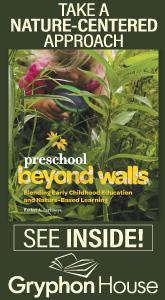ExchangeEveryDay Past Issues
 << Previous Issue
| View Past Issues | | Next Issue >>
<< Previous Issue
| View Past Issues | | Next Issue >> -John Ruskin
Lella Gandini, writing in the book, Connecting: Friendships in the Lives of Young Children and Their Teachers, edited by Dennie Palmer Wolf and Bonnie Neugebauer, describes the “social climate” of many Italian preschools:
“One event has always stuck in my mind as illustrating this climate. Once on a visit to an Italian child care center, I saw a little girl snatch a balloon from another three year old, who burst into tears. The teacher came over and knelt down to speak to the little girl who was hanging on to the balloon fiercely. All the teacher said was, “Non vedi che lo fai piangere?” (“Don’t you see you are making him cry?”) The little girl stared at her playmate. The teacher caressed her and then went away, without ever demanding that the child give back the balloon or apologize.
The teacher alerted the child to the feelings of her friend, but never punished or shamed her. She assumed that her role was to highlight the consequences of the little girl’s actions for her friend and then leave the children to find a way of going back to playing together. I was quite struck by how typical the incident was. There was very little concern about property rights, justice, right and wrong. Instead there was an effort on the part of an adult to draw out empathy and to create a situation in which both children could rejoin each other in playing.
That kind of attention to feeling and empathy is stressed at every chance. If a child cries when her mother or father leaves, teachers don’t tend to the tears themselves – they often call over other children and ask them to give kisses, to hold hands, to invite the crying child to play…If one child has trouble sleeping at nap, a teacher may ask another child to climb up on the cot to comfort the restless one; she may even encourage them to sleep side by side – something which I suspect many American teachers might not feel comfortable doing.”
Friendship in the Lives of Young Children and Their Teachers |
|
Offer valid through February 12, 2019 at 11:59 pm Pacific Time. |






Comments (2)
Displaying All 2 CommentsVentura College Child Development Center
Ventura, CA, United States
Even if teachers were comfortable asking a child to sleep next to another who was having difficulty, licensing regulations in most states would not allow it. In California, children must be on separate mats or cots which are at least 12 inches apart - even siblings. The ECERS tool requires that mats or cots be at least 18 inches apart for a score of 5 on that item and 36 inches apart for a score of 7. I feel this highlights a difference between the cultures of each country and what each considers most important.
Maine, United States
Unfortunately Maine regulations for childcare facilities require that children be at least 3 feet from one another at rest time. Regulations often are in conflict with the needs of children.
Post a Comment